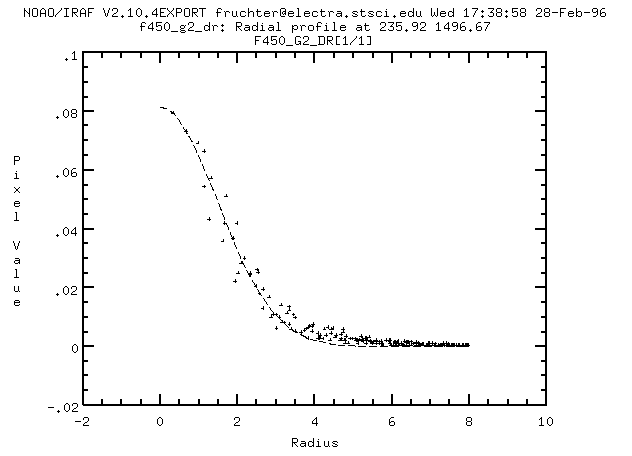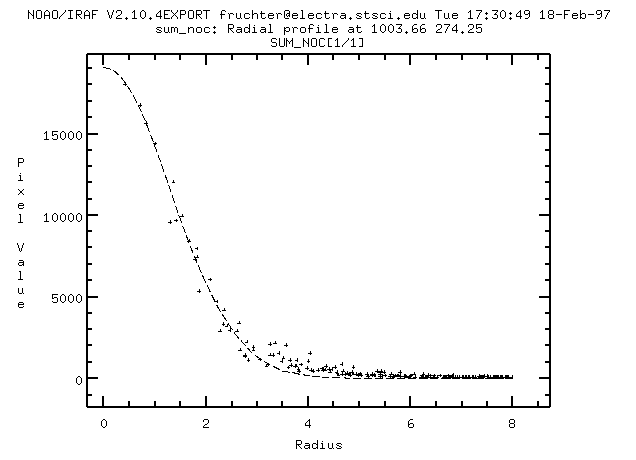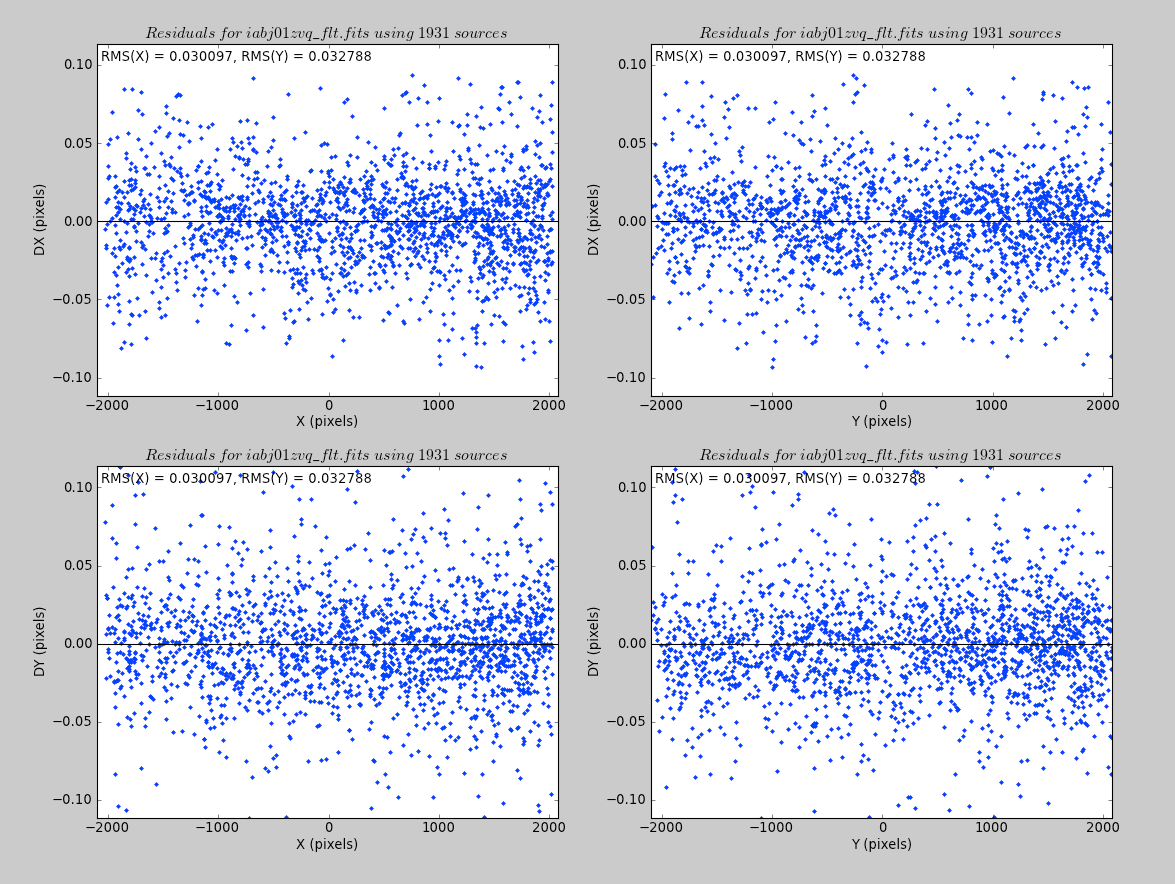3.4 Characteristics of Drizzled Data
Sampling
The theory of the Drizzle algorithm posits that the weight of an input pixel in the final output image is independent of its position on the chip. Therefore, if the dithered images do not uniformly sample the field, the center of light in an output pixel may be offset from the center of the pixel, and this offset may vary between adjacent pixels. Furthermore, the distortion present in the imaging instruments on board HST produces sampling patterns that are not uniform across the field, due to the changing pixel size. This directly impacts the uniformity of the output PSF.
This effect is seen in the HDF-N images, where some pointings were not at the requested position or orientation. Figure 3.4 and Figure 3.5 and show two PSFs compared with best-fitting Gaussians. Although Gaussians are only a crude approximation to the real PSF, they nevertheless suffice to illustrate the point of this particular example.
The upper PSF is taken directly from the HDF-N F450W drizzled image, and displays a substantial amount of variation about the Gaussian fit. In contrast, the lower PSF is a bright star taken from a deep image with a nearly perfect four-point dither, in which the uniform sampling has produced a much smoother PSF. (Note that the difference in the apparent widths of the PSFs is due to the use of larger output pixels in the second image than in the HDF-N: 0.05 vs. 0.04 arcseconds).
Changes in PSF can also result from other problems, such as charge transfer errors in the CCD (Whitmore & Heyer 1997; Heyer 2001). Generally, however, these variations are likely to be less noticeable than effects due to non-uniform subsampling of the PSF.
Photometry
A photometric study of ACS/WFC images, done during extensive testing of the DrizzlePac package, has demonstrated that it is possible to achieve optimal aperture photometry using output from AstroDrizzle, provided that the combined images are carefully aligned and cosmic rays are properly removed.
Tests were run on ACS/WFC images, taken in F606W and F814W, of the open cluster NGC 6791 (Program 9815, PI: I. King). Observations for each filter were taken during separate visits, For each filter, three exposures, each 30 seconds, were taken using POS TARG shifts in a three-way subpixel dither.
For each set, images were aligned using the tweakreg task in DrizzlePac that computes residual shifts between input images (flt.fits) and updates their headers with new WCS information that aligns the images. AstroDrizzle was used to combine each set of images, with careful attention to cosmic ray rejection parameters and image alignment accuracy, to avoid pixels that were not properly masked.
AstroDrizzle is able to provide improved sampling of the PSF relative to the individual input images. This is especially important for wide field HST cameras such as ACS, WFC3/UVIS, and WFC3/IR, where the size of a native pixel is comparable to the full width at half maximum (FWHM) of the PSF. However, for testing purposes, the native size of the ACS/WFC input pixel (0.05 arcseconds) was used for the combined image output scale.
Aperture photometry was performed using the PyRAF package DAOPHOT on a catalog of about 1500 stars. Stellar instrumental magnitudes calculated using individual flt.fits images from the HST pipeline were compared with instrumental magnitudes of the same sources using the AstroDrizzle-combined image.
Results indicate that optimal aperture photometry can be obtained from AstroDrizzle-combined images as long as the processing carefully accounts for image alignment and proper cosmic ray removal. A complete description of the NGC 6791 study is available online at the DrizzlePac website. A more elaborate independent study with similar results, is provided by Kalirai, et al. 2012, AJ, 143, 11.
Astrometry
Astrometry of images taken within the same visit and orbit are generally limited by
- HST's pointing precision which is controlled by the Fine Guidance Sensors (FGS)
- Positional uncertainties of guide stars in the Guide Star Catalog
- PSF centering of the under-sampled HST images
Information about the field, from ground- or space-based images, could be used to improve the inherent absolute astrometry of image.
For images with sufficient well-exposed point sources, relative astrometry for each image can be improved using the DrizzlePac/Tweakreg task - which find accurate offsets and rotation between two images. These updated offsets and rotation can then be folded back into the astrometry information in the image header of each image and used to combine all the exposures into a single well-aligned and drizzled mosaic.
Figures 3.6 and 3.7 show plots of the linear solution between two HST WFC3/UVIS images as output from the DrizzlePac/Tweakreg task for two images with the F606W filter, observed in the same orbit. The RMS of the solution is accurate to 0.03 pixels in X and Y, and shows the random noise in the residual vectors plot across the field.
More in-depth information about astrometry and positional uncertainties are available in Chapter 4.



